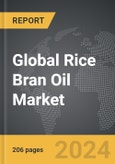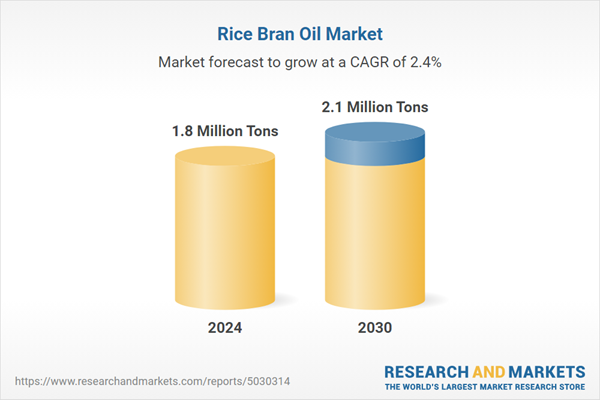Global Rice Bran Oil Market - Key Trends and Drivers Summarized
Unraveling the Market Dynamics of Rice Bran Oil: Health Benefits and Growth Drivers
Rice Bran Oil is extracted from the outer layer of rice grains, known as the bran, and is recognized for its high nutritional value and health benefits. Rich in antioxidants, vitamin E, and healthy fats, rice bran oil is increasingly being used in cooking, cosmetics, and pharmaceuticals. The oil's unique composition, which includes a balance of saturated, monounsaturated, and polyunsaturated fats, makes it a heart-friendly option and a preferred choice for health-conscious consumers. Its high smoke point also makes it ideal for high-temperature cooking methods, such as frying, without the risk of forming harmful compounds. As consumer awareness of health and wellness continues to rise, the demand for rice bran oil is witnessing significant growth across various regions.How Are Technological Advancements Influencing the Rice Bran Oil Market?
Technological advancements in extraction and refining processes are playing a crucial role in enhancing the quality and yield of rice bran oil. The development of advanced extraction techniques, such as cold pressing and solvent extraction, is enabling the production of rice bran oil with higher purity and better retention of natural nutrients. Moreover, innovations in refining technologies, such as enzymatic degumming and molecular distillation, are helping to reduce impurities and improve the oil's stability and shelf life. The integration of digital tools and automation in the production process is further enhancing efficiency and reducing production costs, making rice bran oil more accessible to a broader consumer base.What Are the Challenges and Opportunities in the Rice Bran Oil Market?
The rice bran oil market faces several challenges, including the limited availability of high-quality raw materials, high production costs, and competition from other edible oils, such as olive and canola oil. The extraction of rice bran oil is a complex process that requires significant investment in specialized equipment and technology, which can be a barrier for small and medium-sized producers. However, the market is also filled with opportunities, particularly with the rising demand for healthy cooking oils and the increasing use of rice bran oil in the cosmetics and pharmaceutical industries. The growing trend of clean-label products and natural ingredients is further driving the demand for rice bran oil. Additionally, the expansion of distribution channels, including e-commerce and health food stores, is creating new growth avenues for market players.What Factors Are Driving the Growth of the Rice Bran Oil Market?
The growth in the Rice Bran Oil market is driven by several factors, including the rising consumer awareness of the health benefits associated with the oil's balanced fatty acid composition and antioxidant properties. Technological advancements in extraction and refining processes are enhancing product quality and expanding market accessibility. The growing demand for healthy and natural cooking oils, driven by lifestyle changes and increasing health consciousness, is further boosting market growth. Additionally, the expanding application of rice bran oil in non-food sectors, such as cosmetics and pharmaceuticals, is contributing to market expansion. The rise of online retail channels and the increasing penetration of rice bran oil in emerging markets are also key drivers of growth in this sector.Report Scope
The report analyzes the Rice Bran Oil market, presented in terms of market value (USD). The analysis covers the key segments and geographic regions outlined below.- Segments: Type (Non-Organic, Organic); End-Use (Food & Beverage, Industrial).
- Geographic Regions/Countries: World; United States; Canada; Japan; China; Europe (France; Germany; Italy; United Kingdom; Spain; Russia; and Rest of Europe); Asia-Pacific (Australia; India; South Korea; and Rest of Asia-Pacific); Latin America (Argentina; Brazil; Mexico; and Rest of Latin America); Middle East (Iran; Israel; Saudi Arabia; United Arab Emirates; and Rest of Middle East); and Africa.
Key Insights:
- Market Growth: Understand the significant growth trajectory of the Non-Organic Rice Bran Oil segment, which is expected to reach 1.8 Million Tons by 2030 with a CAGR of 2.1%. The Organic Rice Bran Oil segment is also set to grow at 3.9% CAGR over the analysis period.
- Regional Analysis: Gain insights into the U.S. market, valued at 490.1 Thousand Tons in 2024, and China, forecasted to grow at an impressive 3.7% CAGR to reach 392.2 Thousand Tons by 2030. Discover growth trends in other key regions, including Japan, Canada, Germany, and the Asia-Pacific.
Why You Should Buy This Report:
- Detailed Market Analysis: Access a thorough analysis of the Global Rice Bran Oil Market, covering all major geographic regions and market segments.
- Competitive Insights: Get an overview of the competitive landscape, including the market presence of major players across different geographies.
- Future Trends and Drivers: Understand the key trends and drivers shaping the future of the Global Rice Bran Oil Market.
- Actionable Insights: Benefit from actionable insights that can help you identify new revenue opportunities and make strategic business decisions.
Key Questions Answered:
- How is the Global Rice Bran Oil Market expected to evolve by 2030?
- What are the main drivers and restraints affecting the market?
- Which market segments will grow the most over the forecast period?
- How will market shares for different regions and segments change by 2030?
- Who are the leading players in the market, and what are their prospects?
Report Features:
- Comprehensive Market Data: Independent analysis of annual sales and market forecasts in US$ Million from 2024 to 2030.
- In-Depth Regional Analysis: Detailed insights into key markets, including the U.S., China, Japan, Canada, Europe, Asia-Pacific, Latin America, Middle East, and Africa.
- Company Profiles: Coverage of players such as A.P. Refinery Pvt. Ltd., Emami Agrotech Limited, Gemini Edibles & Fats India Private Limited (GEF India), Gustav Heess Oleochemische Erzeugnisse GmbH, Kaleesuwari Refinery Private Limited and more.
- Complimentary Updates: Receive free report updates for one year to keep you informed of the latest market developments.
Some of the 66 companies featured in this Rice Bran Oil market report include:
- A.P. Refinery Pvt. Ltd.
- Emami Agrotech Limited
- Gemini Edibles & Fats India Private Limited (GEF India)
- Gustav Heess Oleochemische Erzeugnisse GmbH
- Kaleesuwari Refinery Private Limited
- Kasisuri Group of Companies
- KRBL Limited
- Monini SpA
- Mother Dairy Fruit & Vegetable Pvt., Ltd.
- PIA Ingredients, Corp.
This edition integrates the latest global trade and economic shifts into comprehensive market analysis. Key updates include:
- Tariff and Trade Impact: Insights into global tariff negotiations across 180+ countries, with analysis of supply chain turbulence, sourcing disruptions, and geographic realignment. Special focus on 2025 as a pivotal year for trade tensions, including updated perspectives on the Trump-era tariffs.
- Adjusted Forecasts and Analytics: Revised global and regional market forecasts through 2030, incorporating tariff effects, economic uncertainty, and structural changes in globalization. Includes historical analysis from 2015 to 2023.
- Strategic Market Dynamics: Evaluation of revised market prospects, regional outlooks, and key economic indicators such as population and urbanization trends.
- Innovation & Technology Trends: Latest developments in product and process innovation, emerging technologies, and key industry drivers shaping the competitive landscape.
- Competitive Intelligence: Updated global market share estimates for 2025, competitive positioning of major players (Strong/Active/Niche/Trivial), and refined focus on leading global brands and core players.
- Expert Insight & Commentary: Strategic analysis from economists, trade experts, and domain specialists to contextualize market shifts and identify emerging opportunities.
Table of Contents
Companies Mentioned (Partial List)
A selection of companies mentioned in this report includes, but is not limited to:
- A.P. Refinery Pvt. Ltd.
- Emami Agrotech Limited
- Gemini Edibles & Fats India Private Limited (GEF India)
- Gustav Heess Oleochemische Erzeugnisse GmbH
- Kaleesuwari Refinery Private Limited
- Kasisuri Group of Companies
- KRBL Limited
- Monini SpA
- Mother Dairy Fruit & Vegetable Pvt., Ltd.
- PIA Ingredients, Corp.
Table Information
| Report Attribute | Details |
|---|---|
| No. of Pages | 206 |
| Published | December 2025 |
| Forecast Period | 2024 - 2030 |
| Estimated Market Value in 2024 | 1.8 Million Tons |
| Forecasted Market Value by 2030 | 2.1 Million Tons |
| Compound Annual Growth Rate | 2.4% |
| Regions Covered | Global |









